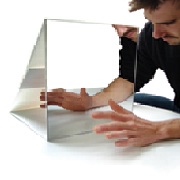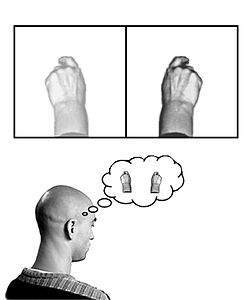Mirror Therapy
Original Editor - Rachael Lowe
Top Contributors - Admin, Joshua Samuel, Sheik Abdul Khadir, Garima Gedamkar, Kim Jackson, Vanessa Rhule, Scott Buxton, Robin Tacchetti, Jess Bell, Alex Benham, Wendy Walker, Rishika Babburu, Evan Thomas, Aicha Benyaich, George Prudden and WikiSysop
Introduction[edit | edit source]
In mirror therapy (MT), a mirror is used to create a reflective illusion of an affected limb in order to trick the brain into thinking movement has occurred without pain, or to create positive visual feedback of a limb movement. It involves placing the affected limb behind a mirror. The mirror is positioned so the reflection of the opposing limb appears in place of the hidden limb.[1]
Clinicians can create this illusion with a mirror box. This device is simply a box with a mirror in the center allowing the hands to be placed on either side of the mirror. The affected limb is always covered while the unaffected limb is placed on the other side so its reflection can be seen on the mirror.
Background[edit | edit source]
Mirror therapy was first proposed as a potential therapeutic intervention by Vilayanur S. Ramachandran to help alleviate Phantom limb pain, a condition in which patients feel they still have a pain in the limb after amputation.
Ramachandran and Rogers-Ramachandran[2] first devised the technique in an attempt to help those with phantom limb pain resolve what they termed a ‘learned paralysis’ of the painful phantom limb. The visual feedback, from viewing the reflection of the intact limb in place of the phantom limb, made it possible for the patient to perceive movement in the phantom limb. Their hypothesis was that every time the patient attempted to move the paralysed limb, they received sensory feedback (through vision and proprioception) that the limb did not move. This feedback stamped itself into the brain circuitry through a process of Hebbian learning, so that, even when the limb was no longer present, the brain had learned that the limb (and subsequent phantom) was paralysed. To retrain the brain, and thereby eliminate the learned paralysis, Ramachandran and Rogers-Ramachandran created the mirror box.[3]
You can read more about mirror therapy through Stephen Sumner's experience who lost his limb some years ago.
Technique[edit | edit source]
The patient places the unaffected limb into one side, and the stump into the other. The patient then looks into the mirror on the side with unaffected limb and makes "mirror symmetric" movements, as a music conductor might, or as we do when we clap our hands. Because the subject is seeing the reflected image of the good hand moving, it appears as if the phantom limb is also moving. Through the use of this artificial visual feedback, it becomes possible for the patient to "move" the phantom limb, and to unclench it from potentially painful positions. To see the mirror box in action, watch this video below by David Butler of the NOI group:
Principle of Mirror Therapy[edit | edit source]
This approach exploits the brain’s preference to prioritise visual feedback over somatosensory/proprioceptive feedback concerning limb position. In conditions such as phantom limb pain (PLP), stroke, or Complex Regional Pain Syndrome Type 1 (CRPS1) where neuropathic processes cause issues with pain, related or unrelated to movement, this approach is thought to offer potential relief.[1]
MT has been shown to increase cortical and spinal motor excitability, possibly through the effect on the mirror neuron system.[4] Mirror neurons account for about 20% of all the neurons present in the human brain. These mirror neurons are responsible for laterality reconstruction i.e., the ability to differentiate between the left and the right side. When using the mirror box, these mirror neurons get activated, which helps in the recovery of affected parts. This system is thought to use the observation of movement to stimulate the motor processes which would be involved in that movement. Similarities have been drawn with motor imagery whereby the individual will mentally imagine movements rather than observing the reflection of a movement in a mirror.[4] However, the neuronal mechanisms behind MT and motor imagery have been suggested to be different.[5] It is thought that the brain's natural inclination to prioritise visual feedback over all others would make MT a more powerful tool. However, research evidence is currently lacking in support of this hypothesis.[1][4] It is to be noted that the major difference in the neuronal reorganisation while using a mirror box is that the ipsilateral hemisphere's neurons give connection to the same-side affected limbs rather than conventional therapies which target the neuronal reorganisation of the contralateral hemisphere. [6][7]
Mirror Therapy in Stroke[edit | edit source]
Mirror therapy (MT) has been employed with some success in treating stroke patients for pain as well as motor function. Clinical studies that have combined mirror therapy with conventional rehabilitation have achieved the most positive outcomes.[8] However, there is no clear consensus as to its effectiveness. In a recent survey of the published research, Rothgangel et al.[9] concluded that: "In stroke patients, we found a moderate quality of evidence that MT as an additional therapy, improves recovery of arm function after stroke. The quality of evidence regarding the effects of MT on the recovery of lower limb functions is still low, with only one study reporting effects. In patients with CRPS and PLP, the quality of evidence is also low."[9]
A recent Cochrane Review[10] summarised the effectiveness of mirror therapy for improving motor function, activities of daily living, pain and visuospatial neglect in patients after stroke. 14 studies with a total of 567 participants that compared mirror therapy with other interventions were compared. At the end of treatment, mirror therapy improved movement of the affected limb and the ability to carry out daily activities, it reduced pain after stroke, but only in patients with a complex regional pain syndrome and the beneficial effects on movement were maintained for six months, but not in all study groups.[10]
Mirror Therapy in Complex Regional Pain Syndromes[edit | edit source]
Working with patients with different complex regional pain syndromes can be challenging. Pharmacological therapies are often associated with a variety of side effects. Mind-body modalities are thought to play a role. However, the lack of clear consensus and a large body of clinical experience makes it hard to provide good evidence-based recommendation to most of our chronic pain patients. Current evidence supports the use of Mirror Box Therapy.[11]
Summary[edit | edit source]
MT is a non-pharmacological and alternative treatment strategy that has been proposed as a means of managing phantom limb pain (PLP). It is a neuro-rehabilitation technique designed to remodulate cortical mechanisms. With this technique, patients perform movements using the unaffected limb whilst watching its mirror reflection superimposed over the (unseen) affected limb. This creates a visual illusion and provides positive feedback to the motor cortex that movement of the affected limb has occurred. The approach is thought to offer potential relief through the visual dominance upon motor and sensory processes.
Considering the importance of PLP and its management, MT offers clinicians an easy-to-use and low-cost adjuvant therapeutic technique. However, its effectiveness as a stand-alone modality largely arises from low-quality evidence. Instead, there is a greater weight of evidence in favour of its use as a combined or sequential therapy, such as Graded Motor Imagery.[12]
References[edit | edit source]
- ↑ 1.0 1.1 1.2 Moseley GL, Gallace A, Spence C. Is mirror therapy all it is cracked up to be? Current evidence and future directions. PAIN. 2008;138(1):7–10.
- ↑ Ramachandran VS, Rogers-Ramachandran DC. Synaesthesia in phantom limbs induced with mirrors, Proceedings of the Royal Society of London. 1996;263(1369):377–86.
- ↑ Ramachandran VS, Rogers-Ramachandran DC, Cobb S. Touching the phantom. Nature. 1995;377:489–90.
- ↑ 4.0 4.1 4.2 Diers M, Christmann C, Koeppe, C, Ruf M, Flor, H. Mirrored, imagined, and executed movements differentially activate sensorimotor cortex in amputees with and without phantom limb pain. PAIN. 2010;149(2):296–304.
- ↑ Deconinck FJ, Smorenburg AR, Benham A, Ledebt A, Feltham MG, Savelsbergh GJ. Reflections on mirror therapy: a systematic review of the effect of mirror visual feedback on the brain. Neurorehabilitation and Neural Repair. 2015 May;29(4):349-61.
- ↑ Vittorio Gallese and Alvin Goldman, Mirror neurons and the simulation theory of mind-reading, Trends in Cognitive Sciences – Vol. 2, No. 12, December 1998, 1364-6613/98/$
- ↑ Ashu Bhasin, MV Padma Srivastava, Senthil S Kumaran, Rohit Bhatia, Sujata Mohanty, Neural interface of mirror therapy in chronic stroke patients: A functional magnetic resonance imaging study, 2012, Neurology India, 60, 6, 570-576.
- ↑ /Subeyaz,S, Yavuzer,G, Sezer,N, Koseoglu,F, Mirror Therapy Enhances Lower-Extemity Motor Recovery and Motor Functioning After Stroke: A Randomized Controlled Trial, Archives Physical Medicine and Rehabilitation, Vol 88, May 2007[1]
- ↑ 9.0 9.1 Rothgangel,S, Braun,S, Beurskens,A, Seitz,R, Wade,D, The clinical aspects of mirror therapy in rehabilitation: a systematic review of the literature, Journal of Rehabilitation Research, 34:1-13,2011[2]
- ↑ 10.0 10.1 Thieme H, Mehrholz J, Pohl M, Behrens J, Dohle C. Mirror therapy for improving motor function after stroke. The Cochrane Library, 14 March 2012.
- ↑ Lamont K, Chin M, Kogan M., Mirror box therapy: seeing is believing. Explore (NY). 2011 Nov-Dec;7(6):369-72.
- ↑ Bowering KJ, O'Connell NE, Tabor A, Catley MJ, Leake HB, Moseley GL, Stanton TR., The effects of graded motor imagery and its components on chronic pain: a systematic review and meta-analysis. J Pain. 2013 Jan;14(1):3-13. doi: 10.1016/j.jpain.2012.09.007. Epub 2012 Nov 15.








